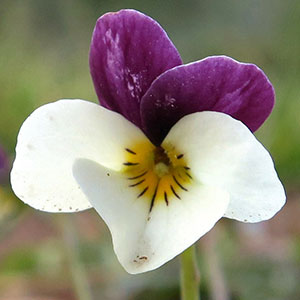Viola hallii
Viola hirsutula
Hall's violet, Oregon violet, wild pansy
southern woodland violet
1–3, decumbent or ascending to erect, ca. 1/2 subterranean, glabrous, clustered on single, short, vertical, deep-seated caudex.
basal and cauline;
basal: 1–4, palmately compound, ± 2-ternate or 3-ternate, leaflets 3;
stipules adnate to petiole, forming 2 linear-lanceolate wings, unlobed, margins entire, apex of each wing free, acute;
petiole 5–8 cm, glabrous;
blade ovate to deltate, 2.8–6 × 2.6–6.5 cm, ± coriaceous, base tapered, ultimate lobes narrowly elliptic, lanceolate, or oblanceolate, 1–7 mm wide, margins entire, ciliate or eciliate, apex acute, mucronulate, surfaces glabrous;
cauline similar to basal except: stipules usually lanceolate, sometimes broadly ovate, ± leaflike, margins toothed;
petiole 1.3–6 cm;
blade 2–4.8 × 1.2–5.5 cm.
basal, 2–4, prostrate or nearly so;
stipules linear-lanceolate, margins entire, apex acute;
petiole 1–10 cm, usually glabrous;
blade unlobed, reniform to ovate, 1–6 × 1–5 cm, base cordate, margins serrate, ciliate or eciliate, apex rounded, adaxial leaf surface with silvery strigose patches.
2.5–11 cm, glabrous.
2–12 cm, glabrous.
sepals lanceolate to ovate, margins ciliate, auricles 0.5–1 mm;
petals: upper 2 almost black abaxially, dark reddish violet adaxially, lower 3 pale yellow, cream, or ± white, lateral 2 bearded, with deep yellow to orange patch basally, dark reddish violet-veined, lowest with deep yellow to orange patch basally, dark reddish violet-veined, 5–18 mm, spur yellow, gibbous, 0.5–2 mm;
style head bearded; cleistogamous flowers absent.
sepals lanceolate to ovate, margins ciliate or eciliate, auricles 1–2 mm;
petals light to deep reddish violet to blue-violet on both surfaces, 3 lower whitish basally, dark violet-veined, lateral 2 densely bearded, lowest 11–17 mm, spur violet, gibbous, 2–3 mm;
style head beardless; cleistogamous flowers on prostrate to ascending peduncles.
ellipsoid, 4–12 mm, glabrous.
ellipsoid, 8–12 mm, glabrous.
light brown, shiny, 3.2–3.5 mm.
beige, mottled to bronze, 1–1.5 mm.
= 60, 72.
= 54.
Viola hallii
Viola hirsutula
Viola hallii was discovered on the grounds of Willamette University in Salem, Oregon, by Elihu Hall, a professor at that institution (V. B. Baird 1942). Leaves of V. hallii are similar to V. beckwithii.
(Discussion copyrighted by Flora of North America; reprinted with permission.)
Viola hirsutula exhibits little phenotypic plasticity. Although considered by N. L. Gil-Ad (1997) to be a putative hybrid, he did not identify the potential parents and chose not to recognize it. A. Cronquist in H. A. Gleason and Cronquist (1991) considered V. hirsutula a form of V. villosa. Viola hirsutula is considered one of the more distinct species throughout its range by McKinney because of the pattern of silvery strigose patches on adaxial leaf surfaces and a more prostrate growth habit than similar species. He believes V. hirsutula is one of the least variable species in the flora. Viola hirsutula appears to occur much less frequently than herbarium collections suggest. Some herbarium specimens are misidentified and represent depauperate plants, usually of V. sororia. These specimens are often hairy on the adaxial leaf surfaces but lack the silvery patches.
Viola hirsutula reportedly hybridizes with V. sororia var. sororia (= V. ×cordifolia [Nuttall] Schweinitz) and V. sagittata var. sagittata (= V. ×redacta House).
(Discussion copyrighted by Flora of North America; reprinted with permission.)


